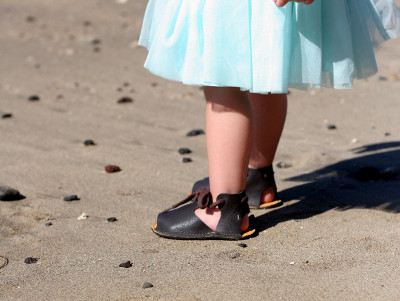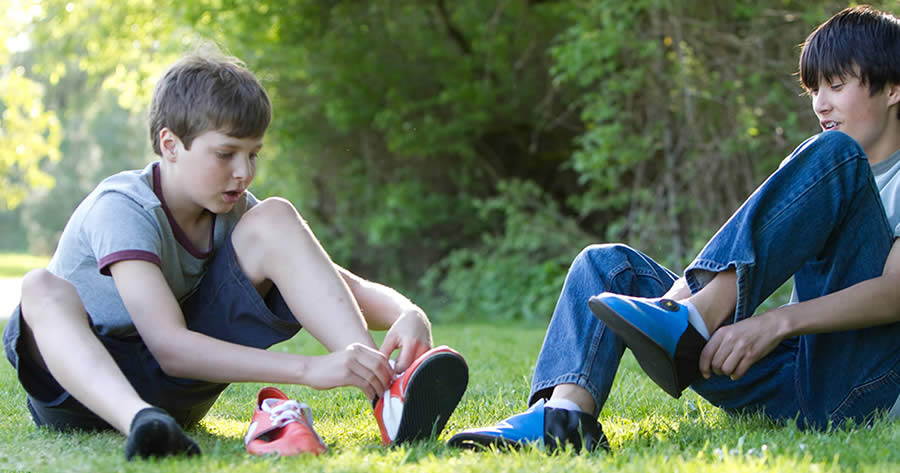When Do Your Feet Stop Growing? How Fast Kids' Feet Grow
One of the most common concerns we hear from parents is the question of how quickly kids' feet grow. They want to ensure the shoe they are buying will last before their baby outgrows them. Toddler years can be a difficult time for sizing feet. Many teenagers seem to need new shoes every few months, so parents want to know when their feet will stop growing. Our experienced customer service elves spend a good portion of every day helping parents find just the right size to get the most use out of a shoe before those tiny toes are bursting at the seams.
We did our research and found some interesting facts regarding the speed of children's foot growth:
- Between ages 1–3, feet can be expected to grow as much as 1.5mm in length each month (about 18mm or 3/4 inch per year).
- Between ages 3–6, children's feet grow an average of 1mm in length each month (about 12mm or 1/2 inch per year).
- Between ages 6–10, children's feet grow somewhat less than 1mm per month in length (slightly under 12mm or 1/2 inch per year).
- Between ages 12–17, a boy’s foot will only grow an additional 10% and girls only about 2%.
As you can see on our child sizing chart, most shoe sizes for kids' shoes differ by about 6-9mm, approximately 1/4–1/3 inch. Taking this into consideration, the above data suggests that children between ages 1–3 will need new shoes 2–3 times a year, and children ages 3–10 will need new shoes 1–2 times a year.
Is that exactly what you can expect to see with your child's foot growth? Consider these variables:
1. Kids' Feet Grow Differently
Not all children hit growth spurts at the same time. Many Softstar elves have kids of their own, and they will attest firsthand that a five-year-old child can sometimes go close to a year with the same size foot, then suddenly grow three sizes over the next six months. If your child seems to be growing faster or slower than the average rates shown above, don't panic—it's normal. There's also nothing wrong with a child having feet a few sizes larger or smaller than the average. We often see toddlers the same age wearing shoes two or three sizes apart. They could both easily end up the same size after a couple years (and if they don't, that's still normal).
2. You Can Cheat
Sometimes you can "cheat" a size by going a little larger, especially with minimalist shoes that are meant give room for feet to stretch and spread. We see a lot of kids in our showroom at the end of the summer in need of new school shoes. Parents want shoes that will last the whole school year, and we often try to find a size that is slightly too big to allow ample growing room.
One rule of thumb (literally) is to make sure there is about an adult thumb's width of space between the end of the toes and the front seams of the shoes while the child is standing in them. Of course, you can go TOO big, which can lead to problems. It's important to make sure your child can walk and run comfortably in the shoes without tripping or stumbling. This is especially important for new walkers who already trip and stumble enough on their own. Visitors to our workshop will often notice kids racing across our showroom under close observation.
3. Open-Toed Sandals Give Room for Feet to Grow
Toes pushing against the front seam of a shoe are a strong sign that a shoe is too small. It's important to give space for those tiny footsies to spread, as constricting feet can lead to a multitude of foot problems. A sandal with an open toe, however, will give more room for the toes and can sometimes prolong the life of a shoe by almost another size. We see this frequently during the summer with kids in our workshop. If you do try to get more life out of a sandal, it's important to remember to check the rest of the shoe for fit as well. If the sides or instep of the shoe are constricting your child's foot, or if your child's toes are hanging over the front edge of the sole, then it's time for a new pair.

4. Newborn Feet are Special
Between 0–12 months, infants can go through four shoe sizes, but we don't recommend buying shoes for the first 6 months (which is why our shoes start at size 2). Even after 6 months, it's usually recommended to wait until their first steps before purchasing a pair of shoes. Those tiny feet are very delicate during the first year, and going barefoot will encourage natural and strong foot development. If you do see a need to give your baby's feet protection, we recommend booties or warm, loose-fitting socks.
So how fast will your kid's feet grow and how often will you need new shoes? The most accurate answer: it depends. But if you want a general rule about what to expect, we offer this advice that is by no means set in stone:
2 sizes per year in the first 3–4 years,
1 size per year after that.
Check out our unisex shoe size chart for more sizing tips and shoe size charts to translate your child's foot size to a Softstar shoe size.
When Do Your Feet Stop Growing?
Yet again, the most accurate answer is: it depends. But, the rule of thumb is as follows:
- Girls: Feet stop growing around age 13–14
- Boys: Feet stop growing around age 16–18
- If puberty starts early or late, then that is likely to correlate to when feet stop growing.
However, growth may continue until about the age of 20. That's because there are growth plates within the foot that typically close up between 18–20 years of age.
It's also important to consider that even in adulthood, the way shoes fit can change drastically. Once you transition to barefoot shoes, your feet are likely to get wider. Aging factors like weight fluctuations and hormonal changes can also cause you to need to shop for different sizes or widths of shoes than before.
[Why is the right size so important for kids? Learn more in our post: "Wikler's Quest for Healthy Children's Feet"]

Martin is a lifelong runner who began wearing minimalist shoes over 10 years ago when he found they alleviated his chronic foot pain, which eventually disappeared completely. He further studied proper running form through a series of workshops taught by the inventor of Correct Toes Toe Spacers, Dr. Ray McClanahan DPM. Martin has collaborated with several health care professionals to collect and share peer-reviewed studies that show the benefits of minimalist footwear. In his personal life, Martin loves living in the Pacific Northwest because it allows him to enjoy a variety of outdoor activities year-round, including hiking, cycling, rock climbing, surfing and snowboarding.


What some of us need is a shoe rental program between the ages 10-12. They truly need a new pair of shoes every month at this age. ;)
My son will become 3 in June. He has a size 12!
And my daughter of 4 years old has a size 10.
The feet of my daughter of 4 don's grow very fast. The feet of my son grow tremendously! I guess he needs size 1 of the youth collection when he is 3,5...
http://hintmama.com/2013/09/17/todays-hint-have-your-child-wear-used-shoes/
It may help for you to try this printable sizing guide for our size 10 shoes. It shows width standards so you can see at a glance if she would do better in a narrow shoe. You can also find these guides for other child sizes on our sizing page:
http://www.softstarshoes.com/PDF/10_shoe_200801.pdf
I hope that helps. Feel free to contact us with any questions. If you're still unsure, you may want to contact our customer service elves directly to discuss it further: 866-763-2525 or [email protected]. They may ask you for instep or heel measurements.
Good luck!
Elf Martin
This is my first child so I have no comparison.
Thanks!
Thank you.
As far as the differences between us and Robeez, here's what we wrote for our FAQ:
Soft Star Moccasins have been made with the same great fitting design since 1989. Robeez shoes were introduced later, and adopted our elastic closure system. However, the similarities stop there.
Soft Stars are the only shoes with soft, moisture absorbing natural sheepskin soles. The sheepskin sole wicks away moisture and also provides more cushiony protection against toys, gravel or other objects under your toddler's toes.
Our shoes are handcrafted here in the USA, unlike other children's shoes. Most of our leathers come from US based tanneries, which have stringent rules and regulations for worker safety and environmental standards. No formaldehyde is used in the tanning of our leathers (not the case with many imported leathers and shoes).
Finally, our moccasin sizes don't stop at age 4 like the competitors—we make them for infants, toddlers, preschoolers, youths and adults!
Thnk u
[Note from Elf Martin: We edited out the rest of this comment due to its long length and the inclusion of personal information, but the question is asking about the dangers of wearing shoes that are way too big.]
I did a search online for other information about this and unfortunately couldn't find much. I did, however, come across this brief comment by a doctor that touches on the subject: https://www.doctorslounge.com/pediatrics/forums/backup/topic-20175.html. I hope that helps!